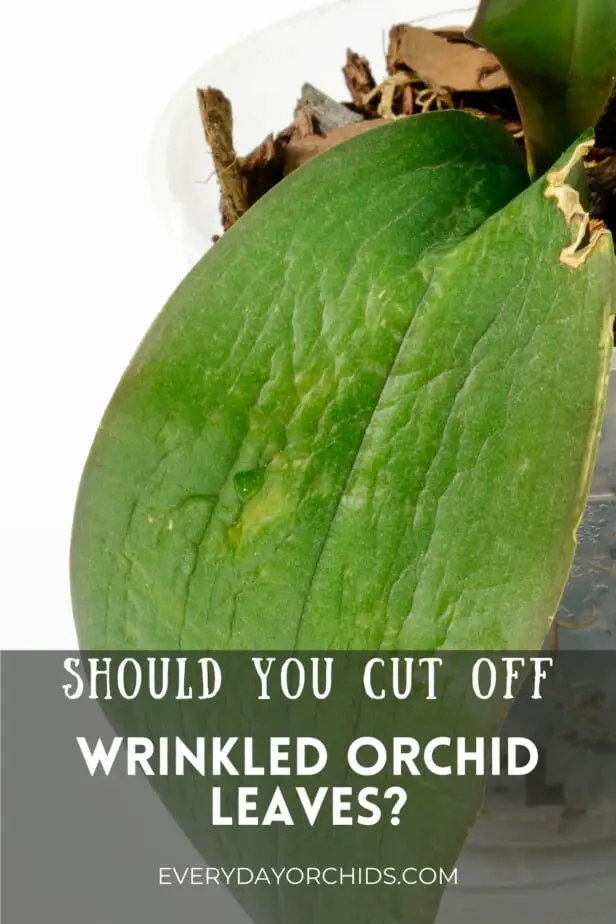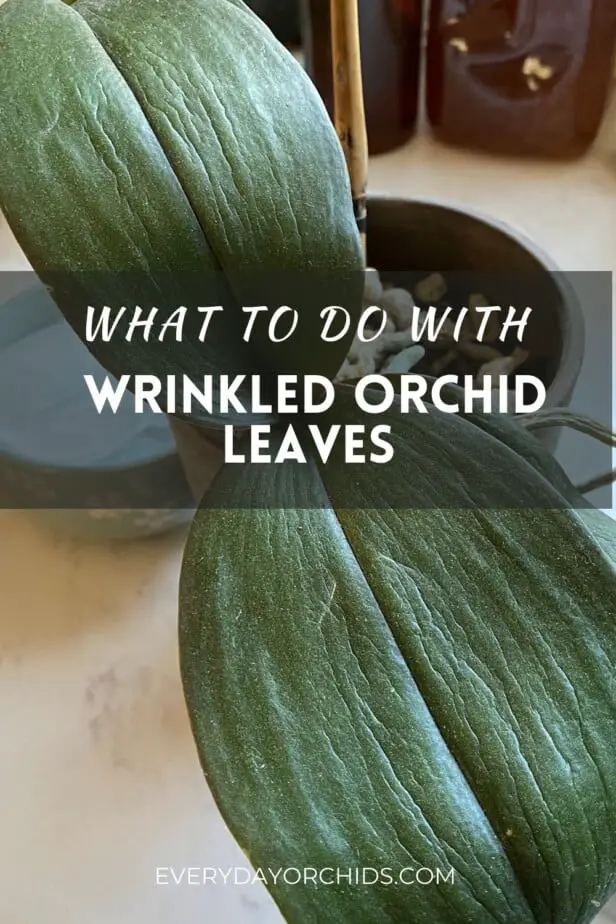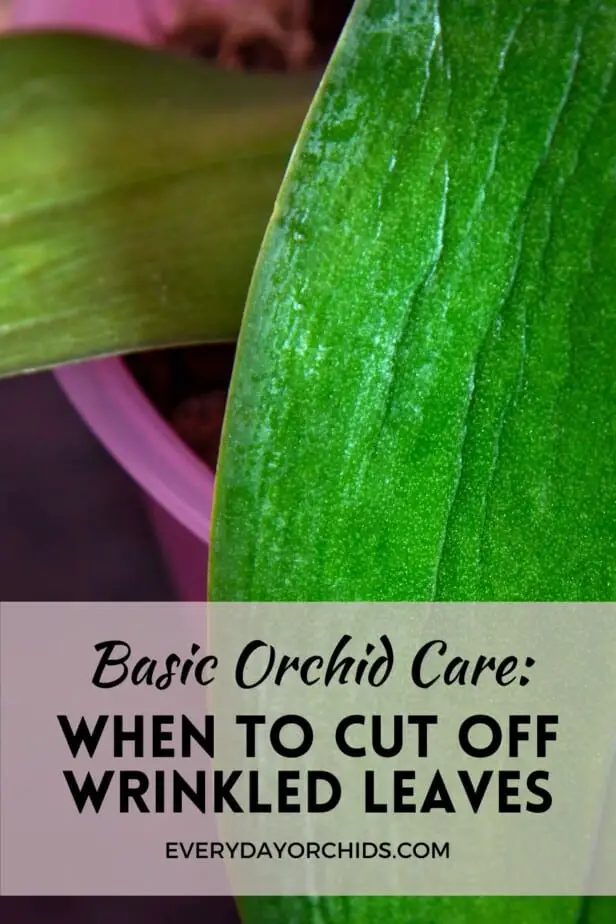When it comes to orchid care, is it a good idea to cut off wrinkled, limp orchid leaves? The thing is, once you notice that your orchid’s leaves are wrinkled, wilted or limp, it will often be too late to reverse these effects. Very rarely do limp, wrinkled, soft orchid leaves rehydrate to become what they used to be.
In many cases, even if you caught the leaf damage early and addressed it, the orchid leaf will still have some residual drooping and wrinkling.
In this case, should you cut off the damaged orchid leaf? Should you leave it on the plant? What do you do with these limp, droopy orchid leaves? I’ll answer those questions below.

You should cut off wrinkled, limp orchid leaves if there are signs of disease, rot or infection. However, in most cases, limp and wrinkled orchid leaves should be left on the orchid. Given time, wrinkled, wilted leaves will regain some or most of their turgor and structure. Wrinkled orchid leaves can be safely left on the orchid.
In this article, I will go over in more detail what you should do with your wilted, wrinkled orchid leaves. You’ll learn what you can expect in terms of recovery after you have addressed the issues that led to the wrinkled orchid leaves. I will also talk about certain scenarios, such as rot or disease, where you will want to remove these wrinkled orchid leaves, and how to go about it. Keep reading to learn more!
Please note that these links are affiliate links and as an Amazon Associate, I earn from qualifying purchases. Purchases made through affiliate links in this post may generate commissions at no additional cost to you. Use this link for a discounted Amazon Prime trial. Thank you for your support!
Table of Contents
What Causes Wilted, Wrinkled Orchid Leaves?
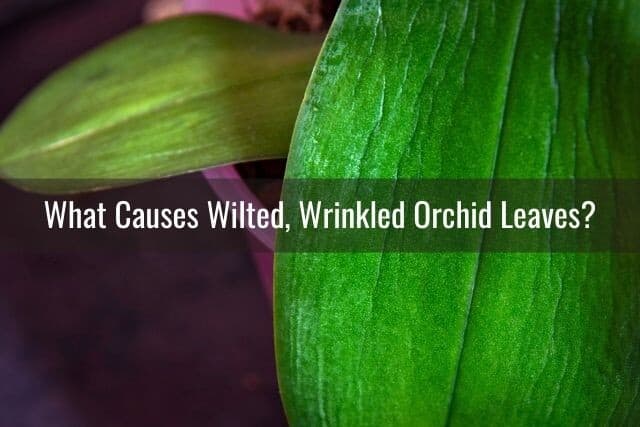
At the most basic level, orchid leaves become limp and wrinkled because the plant is not receiving adequate hydration. The plant cells lose their turgor, or structure, and begin to collapse. This results in drooping and wrinkling of the orchid leaf.
Orchid leaves can become limp, droopy, wrinkled, or wilted for a variety of reasons. The most common reason involves issues with watering, whether it is over or underwatering.
Watering problems can lead to root rot (due to overwatering) or root death (due to dehydration and underwatering). Orchid leaves can also wilt due to decomposing or poor quality potting media, temperature extremes, low humidity, and/or infection and disease.
Everyday Orchids has another post that goes into greater detail about why orchid leaves become wilted, limp, or wrinkled. In that article, you can learn more about how to fix and prevent wrinkled, limp leaves, so be sure to check it out.
Can You Revive Wrinkled Orchid Leaves?
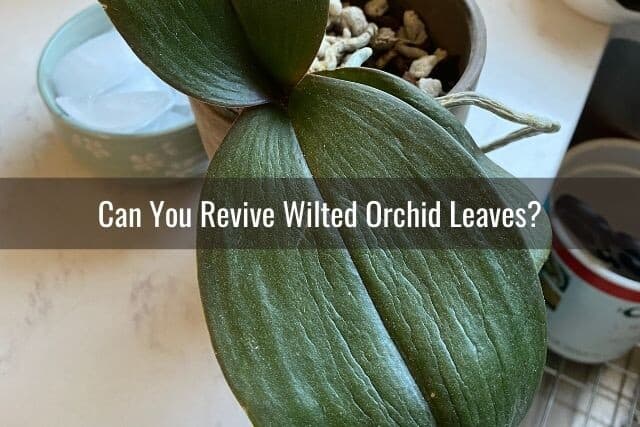
In many cases, it is possible to revive wilted orchid leaves (to some extent). What you do to revive the leaves will depend on what caused the orchid leaves to wilt and become wrinkled in the first place.
Overwatering and Root Rot
If overwatering has led to root rot, this could cause your orchid leaves to begin to wilt and wrinkle. As soon as you notice this change in the leaf structure, stop watering your orchid. Give the potting media some time to dry out.
Before you water your orchid again, check the potting media by placing your finger in the top two inches of potting media. If the potting media is still damp, hold off on watering your orchid for a few more days.
You can read more about how to water an orchid here.
If you catch it early enough, you can stop the leaves from becoming even more limp and wrinkled. Depending on how early you catch it, you may even be able to reverse some of the damage. For example, I had an orchid with which I noticed early on that the leaves were starting to wrinkle, soften and wilt. I stopped watering for a couple of weeks to allow the potting media to dry out. At the end of that time, the leaves were slightly firmer and less wrinkled. Unfortunately, the leaves remained pliable and limp. This led me to believe there was likely enough root damage to justify repotting while the orchid was still in bloom.
Generally, it is best to avoid repotting an orchid when it is in bloom, but there are times when it is better to repot immediately than wait for the orchid blooms to fall off.
Some orchids, such as the Phalaenopsis orchid, may remain in bloom for up to 12 weeks. This is a long time to wait if your orchid is already under stress and showing this in the leaves.
Depending on how severe the leaf damage (and root rot) is, you may choose to repot your orchid at this time and not wait.
Dehydration and Underwatering
On a similar note, if your orchid leaves are wrinkled due to dehydration and underwatering, you can try to rehydrate it. In terms of what to do about wilted, limp orchid leaves, you will want to water your orchid immediately. See if that helps minimize the wrinkling and wilting of the orchid leaf.
The goal is actually to rehydrate the orchid roots. By doing so, you will hopefully rehydrate the orchid leaves and reduce the amount of wrinkling seen.
You can soak the orchid pots for at least ten minutes in a small bucket or basin of water. If the orchid roots are very dry, I would recommend soaking longer or trying an Epsom salt soak.
Of course, if orchid roots are totally dry, shriveled and dead, they won’t be able to absorb water. In this advanced case, those older, wrinkled leaves won’t return back to what they used to be. Soaking and rehydration attempts won’t make any difference and the orchid leaf will stay wrinkled.
If you come across this situation, don’t worry, you can still save your orchid. I have outlined a guide on what to do if your orchid roots are dried and shriveled and how you can help your orchid quickly grow new roots, so please check that out for more information.
Once your orchid starts growing new roots, it will, in time, produce new leaves as well.
How Long Does It Take for Wrinkled, Limp Orchid Leaves to Recover?
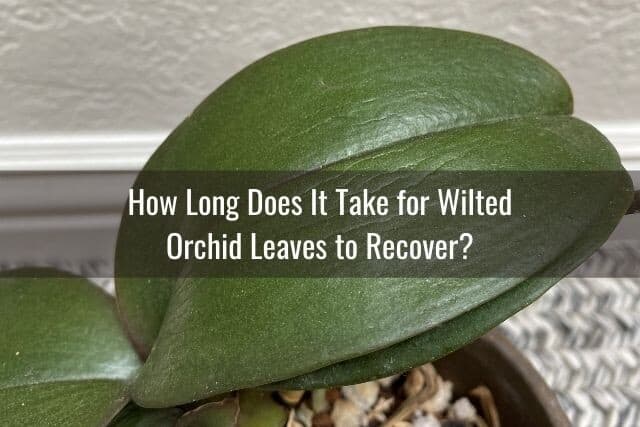
It can take weeks, yes, weeks, before you notice any difference in your orchid leaf recovery process. Remember, orchids grow slowly. Any recovery will be slow as well.
It is important to keep in mind that most of the time, wilted, wrinkled orchid leaves will stay wrinkled. Don’t expect it to look like it did before, and don’t be disappointed if you don’t see any noticeable improvement quickly. The wrinkled, limp leaf may gain some of its turgor back, but it will likely remain limp and wrinkled to some degree.
Instead, if you are properly caring for your orchid, new roots and leaves will grow. These new leaves will be smooth and wrinkle-free. As the older leaves age, they will eventually die and fall off. Over time, you will have less wrinkled leaves on your orchid, as they get replaced with newer leaves.
When Should You Remove Wrinkled Orchid Leaves?

In most cases, you will want to leave the wilted, wrinkled orchid leaves on the plant. They may look unsightly, but they are still serving a purpose. These wrinkled leaves are still providing nutrients to the orchid and helping with photosynthesis.
In certain situations though, it is best to remove the wrinkled, wilted orchid leaf immediately. I will go into those scenarios below.
Disease, Rot and Infection
If the orchid leaf is wilted and wrinkled due to Fusarium wilt, rot, brown spot or brown rot, you want to remove the leaf as soon as you recognize this. Leaving the leaf on the orchid will only allow the infection to spread throughout your orchid plant, and possibly to your other orchids.
Likewise, if the orchid leaf is diseased or infected with a virus, bacteria or fungus, you will want to remove the leaf ASAP. This is true whether it is limp and wilted or still is firm and wrinkle-free.
How to Remove Orchid Leaves
When removing any part of an orchid plant, whether it is dead or diseased, be sure you use sterile cutting tools to prevent further spread of infection. You can sterilize the blades of your scissors or gardening shears with a 10% bleach solution or rubbing alcohol.
To remove the wrinkled, diseased orchid leaf, cut off the leaf at its base. Throw away the leaf. Seal the cut end of the orchid with ground cinnamon powder. This will help dry up and seal the open wound. Ground cinnamon is also a fungicide and will help prevent further infection.
Why Do Orchid Leaves Become Limp After Repotting?
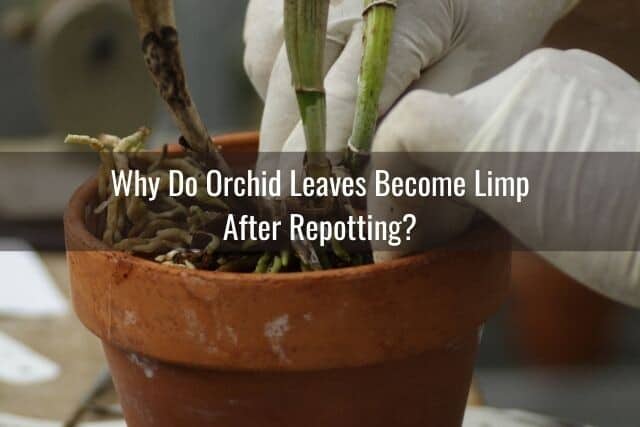
Now, let’s talk about another scenario that can occur after repotting. You might have noticed that after you repotted your orchid, the orchid leaves started to droop and become limp. What happened? Repotting your orchid was supposed to help it, right?
Well, there are a couple of reasons why this happens.
New Potting Media
First, the old potting media was likely broken down and decomposing. The smaller pieces in the potting media would have allowed for more water retention and moisture around the roots.
By switching to new orchid potting media, there will be larger bark pieces that allow for better drainage and decreased water retention. There will be less moisture in the potting media.
This is not a bad thing. Remember, increased moisture around the orchid roots and in the potting media can lead to problems such as root rot, mold, and fungus gnat infestations. It is also a good practice to repot the orchid and change out the potting media every couple of years or so, once it starts to break down and decompose.
However, because the new orchid potting media is better draining and will dry out more quickly, you will need to pay closer attention to your orchid’s watering needs after repotting. There is a risk of the orchid becoming dehydrated. Wilted, wrinkled orchid leaves after repotting could be a sign of dehydration.
Since the new potting media dries out more quickly, you may have to adjust your watering frequency so that you water a little more frequently. Orchids typically need to be watered again once the orchid potting media is nearly dry. You can figure out when this happens by putting your finger in the potting media.
You may also need to provide your orchids with humidification, whether it be through a humidifier or a humidity tray.
Stress Related to Environmental Changes
Another reason why orchid leaves may become wilted and droopy after repotting is due to the stress related to repotting. Most likely, when you repotted your orchid, you also had to cut off dead, rotted, or dried up roots. This can be a traumatic experience for the orchid.
In addition, the orchid is placed into a new potting media. It will take some time for the orchid to adjust to the new environment.
What To Do With Wrinkled Orchid Leaves After Repotting
As long as your orchid is receiving proper water and humidity, and you have ensured that there is no rot, disease or infestation, leave the wilted leaves on the orchid.
Repeat: Do not remove any of the wilted orchid leaves that you may see after you repot your orchid.
Given some time, the orchid will acclimate to the new environment and the slightly wilted, limp orchid leaves will recover.
Final Thoughts
Wilted, limp and wrinkled orchid leaves may not be aesthetically pleasing, but in most cases, it is better to leave them on the orchid rather than cut them off. As the orchid recovers, it will produce new, healthy leaves. The wilted and wrinkled orchid leaf will eventually fall off on its own due to age.
If, however, the orchid leaf is wrinkled or limp due to disease or an infection, you should cut off the wrinkled orchid leaf immediately. This will help prevent the spread of infection and hopefully save your orchid.
If you enjoyed this article, please pin it and share!
